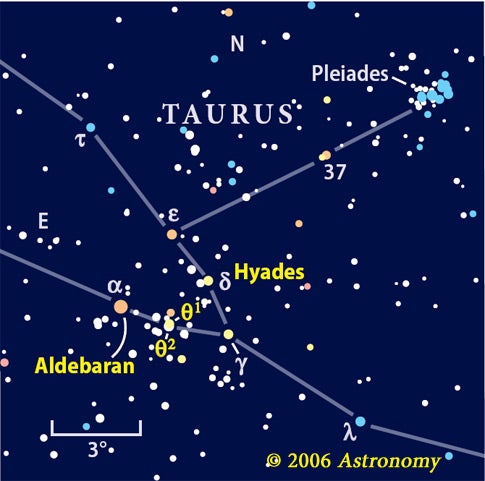The bright orange star Aldebaran, which marks the bull’s eye, dominates Taurus. The rest of Taurus’ head is outlined by a V-shape pattern of fainter stars called the Hyades. In ancient Greek, “hyades” means “rain.” The name undoubtedly comes from the fact that the Mediterranean region experiences rainy seasons in May and November, just as the Hyades are setting in the early evening and early morning, respectively. In Greek mythology, the Hyades are sisters, the daughters of Aethra and Atlas and half-sisters to the Pleiades. They can be traced back to about 750B.C., when the Greek poet Homer included the Hyades in his Iliad about the Trojan War.
Just how many of the Hyades sisters can you count by eye? Fifteen shine brighter than 5th magnitude, but binoculars quickly raise that number into the dozens. In fact, hundreds of stars lie inside the cluster’s 5.5° span. More than 130 of them are brighter than 9th magnitude and should be visible in binoculars under reasonably dark skies.
The cluster’s large apparent size poses some problems when trying to view it. It’s so large that telescopes can’t take it all in at once. Even some binoculars can’t squeeze the cluster’s full extent into their fields of view. The best view of the Hyades will be through binoculars that have fields of view between 7° and 9° in diameter. Anything less and the clustering effect will be lost; sometimes in stargazing, you can’t see the forest for the trees.
However, one of the Hyades “sisters” is an imposter. This celestial fraud is none other than brilliant Aldebaran itself. Aldebaran does not belong to the Hyades, despite appearances. Instead, it lies in the foreground, between the cluster and us. It just happens to fall along the same line of sight. The Hyades cluster is 150 light-years from Earth, which makes it one of the closest to us, but Aldebaran is only about 65 light-years away.
The brightest true cluster star, therefore, is Theta2 (θ2) Tauri at magnitude 3.4. Theta2 teams with 3.8-magnitude Theta1 (θ1) Tauri to form a wide naked-eye double star just southwest of brilliant Aldebaran. Can you make them both out by eye alone? Theta2 is classified as a white giant star, which means that it is both hotter and larger than our Sun. Theta1 is a yellow star, like the Sun. But since Theta1 is a yellow giant, it is actually much larger than our Sun.
A careful study of the Hyades through binoculars will reveal other stellar duets and trios. Look for two fainter pairs of stars through your binoculars to the northeast and southeast of the Thetas. I also see a delta wing formed from the stars Delta, 63, 64, and 68 Tauri to the west of Aldebaran.
If you scan various deep-sky catalogs, you may find the Hyades referred to by their catalog designation, Melotte 25. This designation originated in 1915, when Philibert Jacques Melotte (1880–1961) published his Catalogue of Star Clusters Shown on the Franklin-Adams Chart Plates. Seven years earlier, American astronomer Lewis Boss (1846–1912) discovered the Hyades form a true open star cluster. His studies found that all of the stars are moving in the same general direction and speed within the Milky Way. Later studies also showed the Hyades share a common origin, as the stars are an average of 790 million years old. The stars in the nearby Pleiades (M45), by contrast, are only about 100 million years old.
Speaking of the Pleiades, they are also an awesome sight through just about any binoculars. Be sure to stop by and pay them a visit, as well as the Hyades, every chance you get this winter. Several other lesser-known open star clusters also lie within Taurus and are just waiting for your visit. And that’s no bull!










